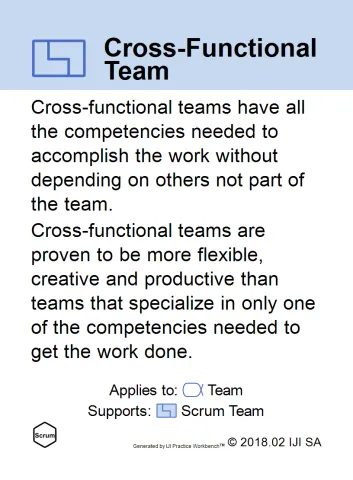Editor’s Note: We recommend that you read Part One, Two, Three , Four and Five of the Better Essence Through Scrum series before reading Part 6.
Scrum Teams do not work in isolation but need to effectively integrate into the business environment involving the right customers and stakeholders in the right events. At the right time and in the right way. This involves setting up the appropriate relationships between the various parties involved. Doing this upfront using the practice cards means nothing is forgotten and avoids the pain when assumptions made are not met.
The game is useful wherever there is a perceived boundary between a Scrum Team and its customers. The two most common situations, which we will illustrate here, are:
- Where the Scrum Team is seen as part of IT but provides solutions for the business. In this case the game provides a way to establish the boundaries and interactions between business and IT.
- Where a Scrum Team will work across organizations or organizational boundaries. In this case the game provides a way to structure the conversation between a customer and supplier as they agree how they will work together.
The Essence cards have a few different types and for these illustrations we are going to concentrate on the Roles and Activities of Scrum. In this example the only other card added is the Definition of Done work product. When playing the game for the first time it is a good idea to use all the cards even the Scrum Pillars and Scrum Values.
The game uses a simple game board split into two areas, one for each party involved, separated by single line. Responsibilities are then clarified by placing the cards above or below the line. Any joint responsibilities are indicated by placing cards on the line positioned towards the party in the lead.
The first picture illustrates case 1 above where there is a perceived boundary between the Business commissioning the system and the IT team producing it, and the second case 2 where the Customer retains the role of Product Owner while an external Supplier provides the rest of the Scrum Team.
To play the game:
Assemble some representatives of each of the parties involved.
Create a board with a horizontal line, name the two areas to reflect the parties involved for example Businees and IT or Customer and Supplier. Traditionally placing the Scrum Team itself at the bottom of the board.
Place each card to show where responsibility lies:
- Above or below the line - sole responsibility of indicated party, or
- Central on line - shared collaborative activity with equal and joint responsibility, or
- On the line, but not central - responsibility mainly of one party, but with some input, support or agreement required from the other party.
For each card that touches or crosses the line, write a note both above and below the card to briefly describe the respective responsibilities of each party.
Add additional notes to show availability of resources and frequency of interactions.
Don’t be surprised if most activities are on the line as this is typical for an agile way of working such as Scrum and reflects good collaboration.
Both parties should ensure they can commit to the way of working as described, and that there are no commercial or contractual constraints or barriers to working in this way. The end result may be an informal agreement, some explicit policies or, may indeed, form some of the key content of a more formal contract.
Happy contract bridging. Even if you’re not in a formal customer / supplier relationship, you might find value in this game in agreeing working with a Product Owner who comes from your own business but is unclear of what the role entails.
Tip: Make the results visible as an information radiator to remind all parties.
Special thanks to Roly Stimson the originator of the game and the name.
Join us soon for the next game in the series.



